Yung Y.L., DeMore W.B. Photochemistry of Planetary Atmospheres
Подождите немного. Документ загружается.


(a)
(b)
Figure
9.2 (a) The
temperature
(°C)
on a
lifeless
planet
as a
function
of
changing solar luminosity.
The
dotted (solid) line gives
the
results
for
a dry
(wet)
planet.
See
section
9.2:2
for
explanation
of
A-E.
(b)
The
population
of
black
and
white daisies
and
temperature
(°C)
on a
daisy planet
as a
function
of
changing
solar
luminosity.
The
dotted line gives
the
temperature
of a
dry,
lifeless planet. After
Margulis,
L.,
and
Lovelock,
J.
E.,
1989, "Gaia
and
Geognosy,"
in
Rambler
et al.
(1989;
cited
in
section
9.1),
and
Lovelock,
J.
E.,
and
Margulis,
L.,
1974,
"Atmospheric
Homeostasis,
by and for the
Biosphere:
The
Gaia Hypothesis."
Tel/us
26, I.
326

Earth:
Imprint
of
Life
327
narrow range
of
environmental
parameters such
as
temperature
and
water.
We
would
expect
that
as the
solar constant gets larger,
the
light
daisy
will
fare better because
it
reflects more
sunlight
and
consequently
can
remain
cool.
The
dark daisy
will
fare
poorly
in
this
environment.
The net
result
is a
higher population
of
light
daisies
and a
cooler planet. Figure
9.2b
shows
the
evolution
of the two
populations
of
daisies
as the
solar constant increases,
as
well
as the
corresponding temperature
of the
planet. Note
that
the
temperature
has
been maintained
at a
roughly constant value
by
adjusting
the
relative
populations
of the
light
and
dark daisies.
The
biological
homeorrhesis
keeps
the
temperature range
of the
planet
to
within
10°C
while
the
solar constant increases
from
0.7 to 1.3
times
its
present value.
For
comparison,
the
temperature change
is
more than
40°C
for an
abiotic planet. Eventually
Gaia's
control
of the
planet
fails:
When
the
solar
luminosity
rises above
130%
of the
present value, even
the
light
daisies
perish
and the
planet
becomes
lifeless. This shows that
Gaia
can
regulate
the
planetary
environment
only
within
certain
limits.
The
above
is an
artificial
model
of a
hypothetical interaction between
the
envi-
ronment
and the
biosphere.
The
actual interaction
is
much
more
complex
and is not
known.
However, there
is
evidence that
the
existence
and
evolution
of
life
on
this
planet
may
have
had a
profound impact
on the
climate
by
regulating
the
amount
of
CC>2
in the
atmosphere
(see
section
9.4).
9.3
Hydrological
Cycle
The
bulk
of
water
(1.5
x
10
24
g,
equivalent
to 440
atmospheres)
on our
planet resides
in
the
oceans.
A
smaller amount
of
water
is
stored
on
land, mainly
in
glaciers.
The
atmosphere contains
1.3 x
10
19
g of
water vapor.
The
mean volume mixing ratio
is
2 x
10~
3
,
making
it the
fourth
most abundant constituent after
Na,
C>2,
and
Ar.
The
latitude-altitude
profile
of the
mixing ratio
of
water vapor
in the
atmosphere
is
presented
in figure
9.3a.
The
rapid
decrease
of
water vapor with latitude
and
altitude
is
due to its
strong dependence
on
temperature. Between
-30°
and
30°C,
the
saturation
vapor pressure
of
water
is
approximated
by
where
T is
given
in
degrees
K.
Air
entering
the
stratosphere
is
freeze-dried
at the
cold tropopause
with
the
result that
the
middle atmosphere
is
highly
depleted
of
water
vapor.
The
slight increase
in the
mixing ratio
of
water
above
30 km is due to a
chemical
source derived from
the
oxidation
of
CH^
The
latitudinal
variation
of
precipitation
is
shown
in figure
9.3b.
The
maximum
is in the
tropics.
The
decrease
in
water vapor
in
mid and
high latitudes
is
caused
by the
lower temperature. Water plays
a
major role
in
the
energy budget
of the
atmosphere. About
20% of the
solar energy incident
on
the
planet
is
used
to
evaporate water
from
the
surface. This energy
is
released
to the
atmosphere when water vapor condenses
and
returns
to the
surface
as
rain. Thus,
the
hydrological
cycle
is the
primary heat engine
for
driving atmospheric motion.
The
rate
of
evaporation
of
water must
be
balanced
by the
rate
of
precipitation.
The
planetary
mean
rainfall
rate
is 100 cm
yr~'.
The
decrease
at
higher latitudes
in
this rate
is due to
the
lower rate
of
evaporation
at
lower temperatures.
The
evaporation rate
as a
function
of
temperature
is
approximated
by

328
Photochemistry
of
Planetary
Atmospheres
(a)
Figure
9.3 (a)
Zonally averaged specific humidity
(g
kg"
1
)
for
mean annual, winter
(DJF;,
and
summer (JJA) conditions.
The
horizontal axis
is
latitude.
After
Peixoto,
J. P., and
Oort,
A.
H.,
1992,
Physics
of
Climate (New York: American Institute
of
Physics).
The
mean residence time
of
water
in the
atmosphere
is
11
days. Rainout provides
an
efficient
mechanism
for the
removal
of
aerosols,
dust,
and
soluble
species
from
the
atmosphere.
The
annual amount
of
rain falling
on
land
is 9.9 x
10
19
g, and
this
is
essential
for
sustaining
the
biosphere.
A
large fraction
of
this water
(62%)
is
reevaporated into
the
atmosphere.
The
remaining
38%
returns
to the
oceans
in
river
runoffs.
The
hydrological cycle
is the
primary agent
of
mechanical
and
chemical
erosion
of the
continents.
The
combined erosion rate
is
0.81
cm
kyr"
1
of
solids
and
is a
major
source
of
cations
in the
oceans.
A
side
effect
of
chemical
weathering
is the
removal
of
atmospheric
CO
2
by the
dissolution
of
calcium
and
magnesium silicates:
The
rate
of
removal
is
estimated
to be 1.9 ± 0.2 x
10
14
g-C yr
'.
These
reactions
are
very
important
for the
control
of
atmospheric
CO
2
over geologic time.
It
is
convenient
to
divide
the
ocean into
two
layers.
The
uppermost several hundred
meters
of
ocean
is
known
as the
thermocline.
It
exchanges dissolved
gases
and
heat
with
the
atmosphere
in
less than
a
year.
The
bulk
of the
ocean beneath
the
thermocline
does
not
undergo rapid
exchange
with
the
atmosphere.
The
rate
of
exchange
of
water
between
the
upper
and the
deep oceans
is
about
50 Sv (1
Sverdrup
=
10
6
m
3
s~',
or
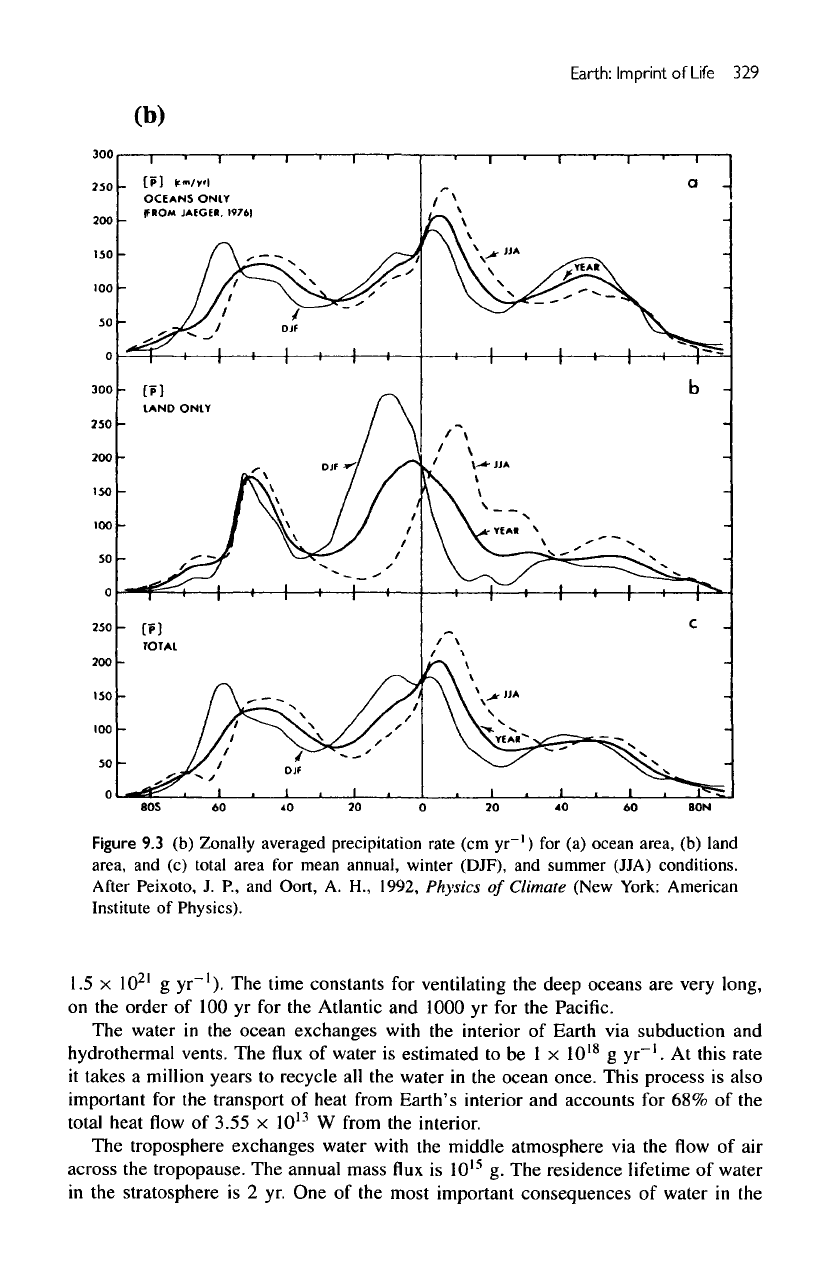
Earth:
Imprint
of
Life
329
(b)
Figure
9.3 (b)
Zonally averaged precipitation rate
(cm
yr~")
for (a)
ocean area,
(b)
land
area,
and (c)
total area
for
mean
annual,
winter
(DJF),
and
summer (JJA) conditions.
After
Peixoto,
J. P., and
Oort,
A. H.,
1992, Physics
of
Climate (New York: American
Institute
of
Physics).
1.5
x
10
21
g yr
').
The
time constants
for
ventilating
the
deep oceans
are
very long,
on
the
order
of 100 yr for the
Atlantic
and
1000
yr for the
Pacific.
The
water
in the
ocean exchanges
with
the
interior
of
Earth
via
subduction
and
hydrothermal
vents.
The flux of
water
is
estimated
to be 1 x
10
18
g
yr~'.
At
this
rate
it
takes
a
million years
to
recycle
all the
water
in the
ocean once. This process
is
also
important
for the
transport
of
heat
from
Earth's interior
and
accounts
for 68% of the
total
heat
flow of
3.55
x
10
13
W
from
the
interior.
The
troposphere exchanges water
with
the
middle atmosphere
via the flow of air
across
the
tropopause.
The
annual mass
flux is
10
15
g. The
residence
lifetime
of
water
in
the
stratosphere
is 2 yr. One of the
most important consequences
of
water
in the
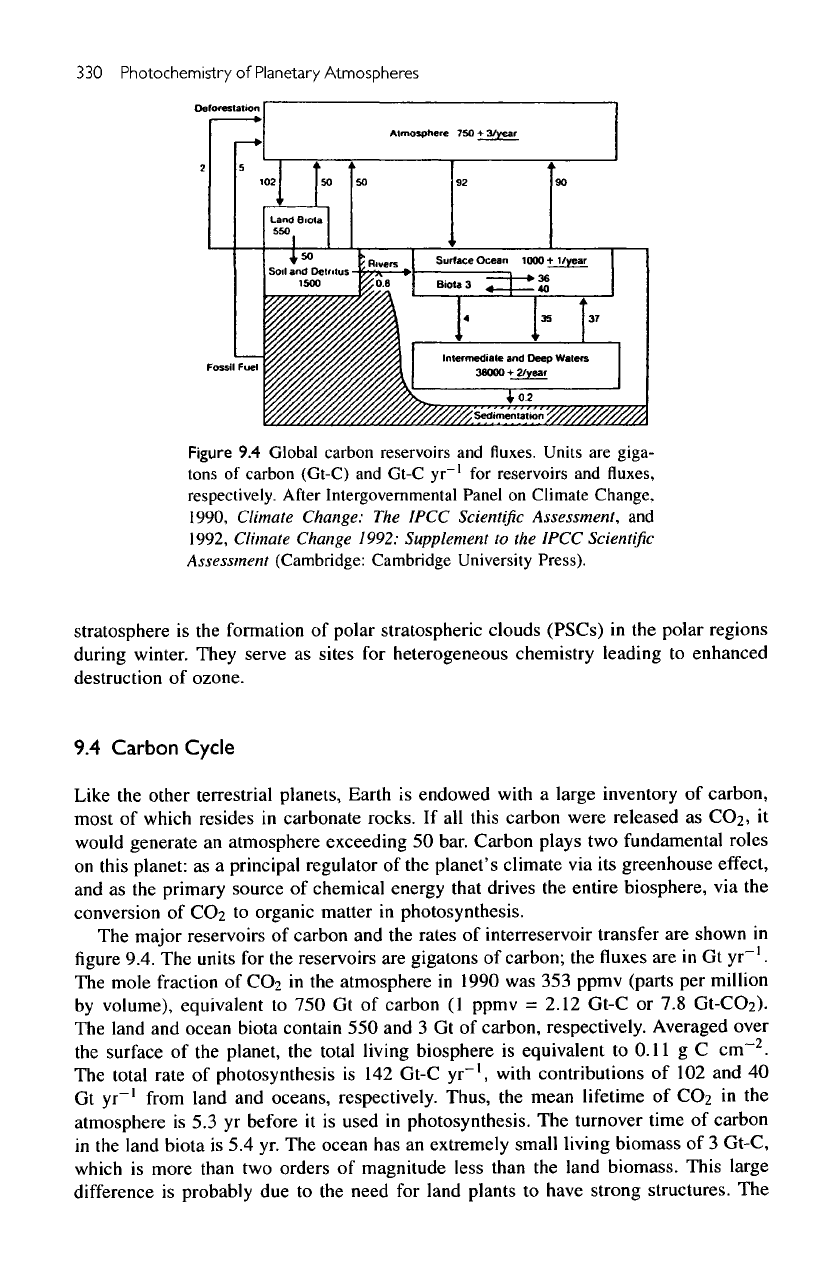
330
Photochemistry
of
Planetary
Atmospheres
Figure
9.4
Global carbon
reservoirs
and fluxes.
Units
are
giga-
tons
of
carbon (Gt-C)
and
Gt-C
yr"
1
for
reservoirs
and fluxes,
respectively.
After
Intergovernmental
Panel
on
Climate Change,
1990, Climate Change:
The
IPCC
Scientific
Assessment,
and
1992, Climate Change 1992: Supplement
to the
IPCC
Scientific
Assessment
(Cambridge: Cambridge
University
Press).
stratosphere
is the
formation
of
polar stratospheric clouds
(PSCs)
in the
polar regions
during
winter. They serve
as
sites
for
heterogeneous chemistry leading
to
enhanced
destruction
of
ozone.
9.4
Carbon
Cycle
Like
the
other
terrestrial
planets, Earth
is
endowed with
a
large inventory
of
carbon,
most
of
which resides
in
carbonate rocks.
If all
this
carbon were released
as
CO2,
it
would
generate
an
atmosphere exceeding
50
bar. Carbon plays
two
fundamental
roles
on
this
planet:
as a
principal regulator
of the
planet's climate
via its
greenhouse effect,
and as the
primary source
of
chemical energy
that
drives
the
entire biosphere,
via the
conversion
of
COa
to
organic matter
in
photosynthesis.
The
major reservoirs
of
carbon
and the
rates
of
interreservoir
transfer
are
shown
in
figure
9.4.
The
units
for the
reservoirs
are
gigatons
of
carbon;
the
fluxes
are in Gt
yr"
1
.
The
mole
fraction
of
CCh
in the
atmosphere
in
1990
was 353
ppmv
(parts
per
million
by
volume),
equivalent
to 750 Gt of
carbon
(1
ppmv
=
2.12
Gt-C
or 7.8
Gt-CO
2
).
The
land
and
ocean biota contain
550 and 3 Gt of
carbon, respectively. Averaged over
the
surface
of the
planet,
the
total
living
biosphere
is
equivalent
to
0.11
g C
cm~
2
.
The
total
rate
of
photosynthesis
is 142
Gt-C
yr~',
with contributions
of 102 and 40
Gt
yr~'
from land
and
oceans, respectively. Thus,
the
mean
lifetime
of
CC>2
in the
atmosphere
is 5.3 yr
before
it is
used
in
photosynthesis.
The
turnover time
of
carbon
in
the
land biota
is 5.4 yr. The
ocean
has an
extremely small living biomass
of 3
Gt-C,
which
is
more
than
two
orders
of
magnitude less than
the
land biomass. This large
difference
is
probably
due to the
need
for
land plants
to
have strong structures.
The

Earth:
Imprint
of
Life
33 I
rate
of
photosynthesis
in the
ocean
is
about
40% of
that
on
land. Thus, marine biota
have
a
turnover time
of 27
days.
The
land
has a
large reservoir
of
detritus
and
dead organic material
in the
soil,
estimated
to be
1500 Gt-C.
The
time
for
exchange between this reservoir
and the
atmosphere
is
much longer,
on the
order
of 30 yr. The
bulk
of the
mobile carbon
reservoir
is in the
oceans,
discussed
in
section
9.4.1.
9.4.1
CO
2
in the
Ocean
The
fate
of
CC>2
in the
oceans
involves complex interactions between solution chem-
istry,
biochemistry,
and
geochemistry.
These
interactions
are
further
complicated
by
the
exchange
of
carbon between
the
upper oceans, where photosynthesis plays
a
major
role
in
transforming inorganic carbon
into
organic carbon,
and the
deep
oceans,
where
decomposition
of
marine organic carbon takes
place.
We
first
consider
a
particularly simple chemical model
of the
ocean involving
carbonate
species
only.
On
dissolving
in
water,
CO2
forms carbonic acid:
where
the
equilibrium constant
for the
reaction
is Kh, the
constant
of
Henry's Law.
Carbonic acid dissociates into bicarbonate
and
carbonate ions:
These
ions interact
with
ions derived from
the
dissociation
of
water:
and
other positive ions, collectively
defined
as
"alkalinity"
(A):
with
HCO
3
~,
CO
3
2
~,
OH~,
and
H+
excluded
from
the
definition
of A.
Note that
all
the
constants
Kh,
K|,
K
2
,
and Kw are
physical constants that
can be
determined
in the
laboratory. However,
the
alkalinity
depends
on the
concentrations
of
metal ions such
as
Ca
2+
and
Mg
2+
,
which
are
determined
by the
geochemistry
of
ocean water
and
transport
of
cations
from
the
continents
via
river
runoffs.
The
above
system
has five
unknowns,
[H
2
CO
3
],
[HCO
3
~],
[CO
3
2
~],
[H+],
and
[OH~],
and five
equations
(9.8)-
(9.12).
The
system
can be
solved once
the
atmospheric
CO
2
and the
ocean
alkalinity
are
prescribed. Note that
the
partitioning
of
carbonate
species
in
solution
is
such that
[HCO
3
~]
:
[CO
3
2
~]
:
[H
2
CO
3
]
=
130:10:1.
The
existence
of
these three carbonate
species
accounts
for the
extraordinary
solubility
of
CO
2
in
water.
The
bulk
of
oceanic
carbon
resides
in
bicarbonate ions
with
concentrations
of
about
2x
10~
2
mole/liter.
For
comparison,
the
concentrations
of
N
2
and
O
2
in
seawater
are
much less, approximately
6 x
10~
4
and 2 x
10~
4
mole/liter, respectively, even though their abundances
in the
atmosphere greatly exceed
that
of
CO
2
.
One
simple consequence
of the
aforementioned
partitioning
of
carbon
species
is the
difficulty
of
detecting changes
in
oceanic carbon
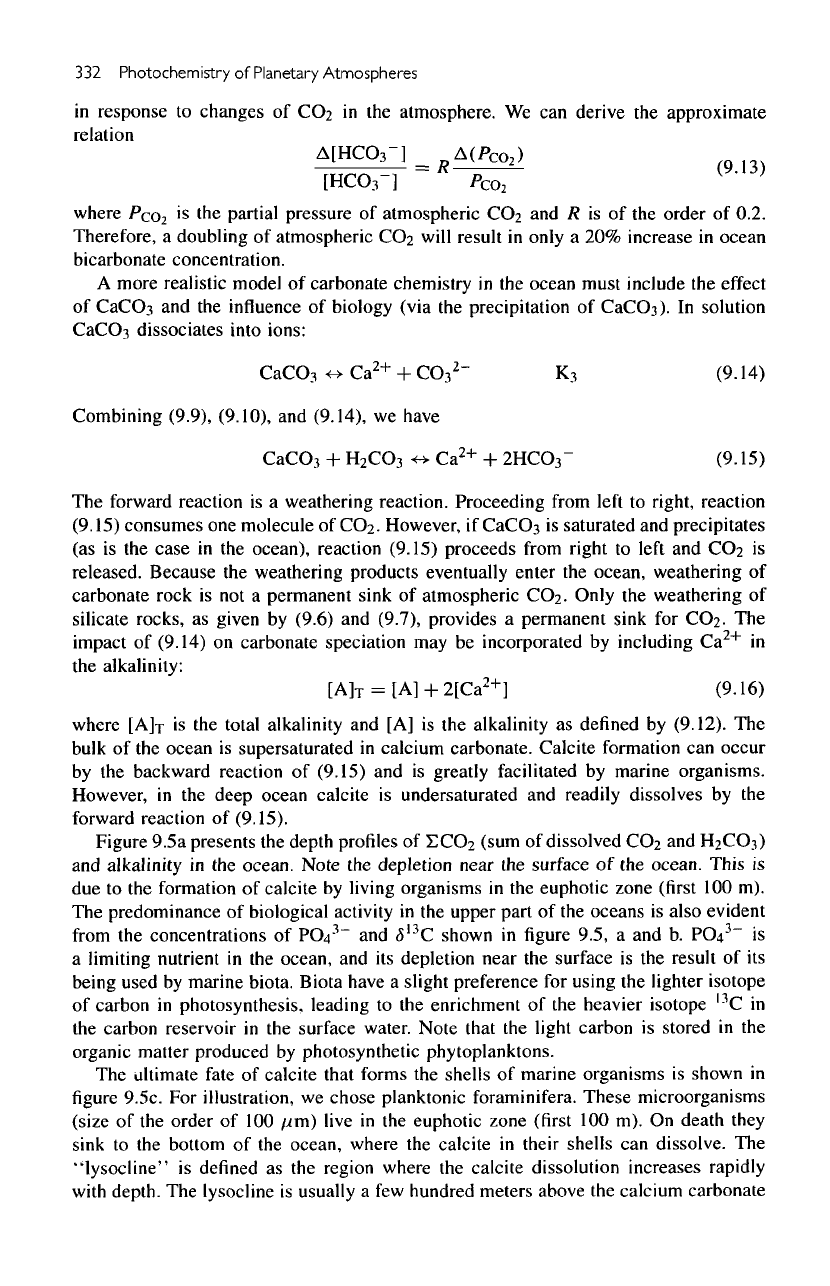
332
Photochemistry
of
Planetary Atmospheres
in
response
to
changes
of CO2 in the
atmosphere.
We can
derive
the
approximate
relation
where
PCC^
'
s
trie
partial pressure
of
atmospheric
CC>2
and R is of the
order
of
0.2.
Therefore,
a
doubling
of
atmospheric
CC>2
will
result
in
only
a 20%
increase
in
ocean
bicarbonate concentration.
A
more
realistic model
of
carbonate
chemistry
in the
ocean
must include
the
effect
of
CaCO
3
and the
influence
of
biology
(via
the
precipitation
of
CaCO
3
).
In
solution
CaCO
3
dissociates into ions:
Combining
(9.9), (9.10),
and
(9.14),
we
have
The
forward reaction
is a
weathering reaction. Proceeding from
left
to
right, reaction
(9.15)
consumes
one
molecule
of
CC>2.
However,
if
CaCO
3
is
saturated
and
precipitates
(as is the
case
in the
ocean), reaction
(9.15)
proceeds
from
right
to
left
and
CC>2
is
released.
Because
the
weathering products eventually enter
the
ocean,
weathering
of
carbonate rock
is not a
permanent
sink
of
atmospheric
CC>2.
Only
the
weathering
of
silicate rocks,
as
given
by
(9.6)
and
(9.7),
provides
a
permanent
sink
for
CO2.
The
impact
of
(9.14)
on
carbonate speciation
may be
incorporated
by
including
Ca
2+
in
the
alkalinity:
where
[A]
T
is the
total
alkalinity
and [A] is the
alkalinity
as
defined
by
(9.12).
The
bulk
of the
ocean
is
supersaturated
in
calcium carbonate.
Calcite
formation
can
occur
by
the
backward reaction
of
(9.15)
and is
greatly facilitated
by
marine organisms.
However,
in the
deep
ocean calcite
is
undersaturated
and
readily dissolves
by the
forward
reaction
of
(9.15).
Figure
9.5a
presents
the
depth profiles
of
ECOi
(sum
of
dissolved
€62
and
H2CO
3
)
and
alkalinity
in the
ocean.
Note
the
depletion near
the
surface
of the
ocean.
This
is
due to the
formation
of
calcite
by
living
organisms
in the
euphotic zone
(first
100 m).
The
predominance
of
biological
activity
in the
upper part
of the
oceans
is
also
evident
from
the
concentrations
of
PO4
3
~
and
5
13
C
shown
in
figure
9.5,
a and b.
PO4
3
~
is
a
limiting
nutrient
in the
ocean,
and its
depletion near
the
surface
is the
result
of its
being
used
by
marine biota. Biota have
a
slight preference
for
using
the
lighter isotope
of
carbon
in
photosynthesis, leading
to the
enrichment
of the
heavier isotope
I3
C
in
the
carbon reservoir
in the
surface water. Note
that
the
light
carbon
is
stored
in the
organic matter
produced
by
photosynthetic phytoplanktons.
The
ultimate
fate
of
calcite
that
forms
the
shells
of
marine organisms
is
shown
in
figure
9.5c.
For
illustration,
we
chose
planktonic
foraminifera.
These
microorganisms
(size
of the
order
of 100
nm)
live
in the
euphotic zone
(first
100 m). On
death they
sink
to the
bottom
of the
ocean, where
the
calcite
in
their
shells
can
dissolve.
The
"lysocline"
is
defined
as the
region where
the
calcite
dissolution
increases
rapidly
with
depth.
The
lysocline
is
usually
a few
hundred meters above
the
calcium
carbonate
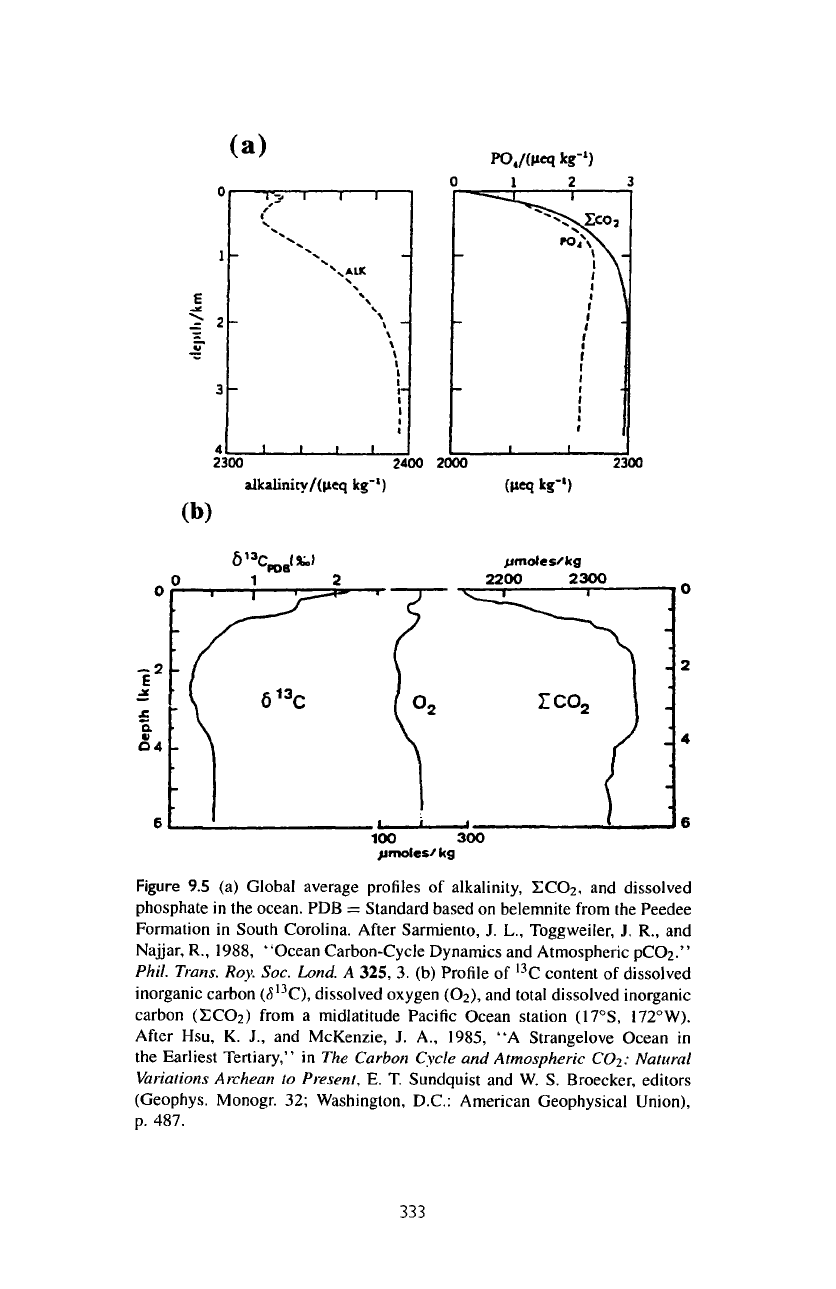
(a)
(b)
Figure
9.5 (a)
Global average
profiles
of
alkalinity,
ECO
2
,
and
dissolved
phosphate
in the
ocean.
PDB =
Standard based
on
belemnite
from
the
Peedee
Formation
in
South Corolina.
After
Sarmiento,
J. L.,
Toggweiler,
J. R., and
Najjar,
R.,
1988,
"Ocean
Carbon-Cycle
Dynamics
and
Atmospheric
pCO
2
."
Phil. Trans. Roy.
Soc.
Land.
A
325,
3. (b)
Profile
of
I3
C
content
of
dissolved
inorganic
carbon
(i5
13
C),
dissolved oxygen (02),
and
total
dissolved inorganic
carbon
(SCO
2
)
from
a
midlatitude
Pacific
Ocean
station (17°S,
!72°W).
After
Hsu,
K.
J.,
and
McKenzie,
J.
A.,
1985,
"A
Strangelove Ocean
in
the
Earliest Tertiary,"
in The
Carbon Cycle
and
Atmospheric
COi:
Natural
Variations
Archean
to
Present,
E. T.
Sundquist
and W. S.
Broecker, editors
(Geophys.
Monogr.
32;
Washington, D.C.: American Geophysical
Union),
p.
487.
333
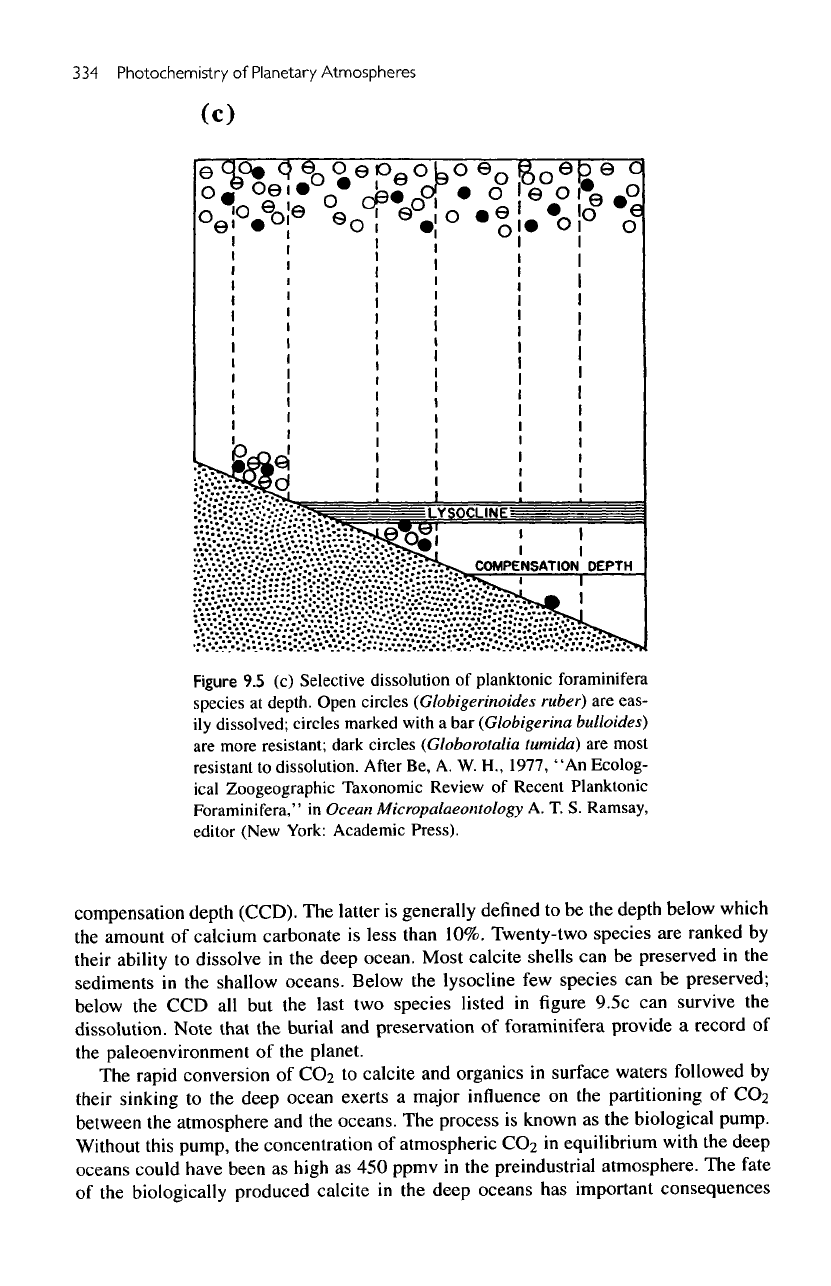
334
Photochemistry
of
Planetary
Atmospheres
(C)
Figure
9.5 (c)
Selective dissolution
of
planktonic
foraminifera
species
at
depth. Open circles
(Globigerinoides
ruber)
are
eas-
ily
dissolved; circles marked
with
a bar
(Globigerina
bulloides)
are
more resistant; dark circles
(Globomtalia
tumida)
are
most
resistant
to
dissolution.
After
Be, A. W. H.,
1977,
"An
Ecolog-
ical
Zoogeographic
Taxonomic
Review
of
Recent Planktonic
Foraminifera,"
in
Ocean
Micropalaeontology
A. T. S.
Ramsay,
editor
(New York: Academic Press).
compensation depth (CCD).
The
latter
is
generally defined
to be the
depth below which
the
amount
of
calcium carbonate
is
less
than 10%. Twenty-two
species
are
ranked
by
their
ability
to
dissolve
in the
deep ocean. Most calcite shells
can be
preserved
in the
sediments
in the
shallow oceans. Below
the
lysocline
few
species
can be
preserved;
below
the CCD all but the
last
two
species listed
in figure
9.5c
can
survive
the
dissolution.
Note
that
the
burial
and
preservation
of
foraminifera
provide
a
record
of
the
paleoenvironment
of the
planet.
The
rapid conversion
of
CO
2
to
calcite
and
organics
in
surface waters followed
by
their
sinking
to the
deep ocean exerts
a
major
influence
on the
partitioning
of
COa
between
the
atmosphere
and the
oceans.
The
process
is
known
as the
biological pump.
Without
this
pump,
the
concentration
of
atmospheric
CO
2
in
equilibrium with
the
deep
oceans could have been
as
high
as 450
ppmv
in the
preindustrial atmosphere.
The
fate
of
the
biologically produced calcite
in the
deep
oceans
has
important consequences
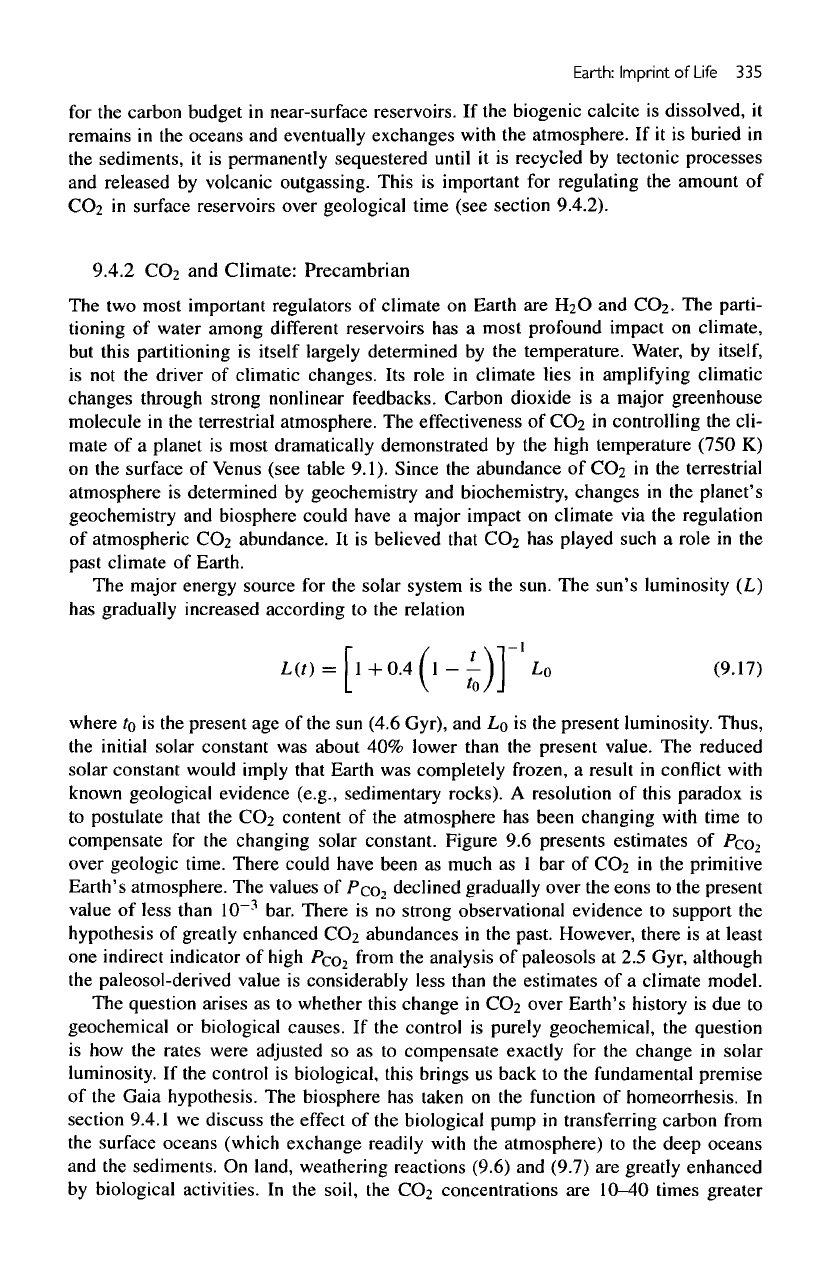
Earth:
Imprint
of
Life
335
for
the
carbon budget
in
near-surface reservoirs.
If the
biogenic calcite
is
dissolved,
it
remains
in the
oceans
and
eventually exchanges with
the
atmosphere.
If it is
buried
in
the
sediments,
it is
permanently sequestered
until
it is
recycled
by
tectonic
processes
and
released
by
volcanic outgassing. This
is
important
for
regulating
the
amount
of
CO2
in
surface reservoirs
over
geological time (see section
9.4.2).
9.4.2
CO
2
and
Climate:
Precambrian
The two
most important regulators
of
climate
on
Earth
are H2O and
CC>2.
The
parti-
tioning
of
water among
different
reservoirs
has a
most profound impact
on
climate,
but
this partitioning
is
itself largely determined
by the
temperature. Water,
by
itself,
is not the
driver
of
climatic changes.
Its
role
in
climate lies
in
amplifying
climatic
changes through strong nonlinear feedbacks. Carbon dioxide
is a
major greenhouse
molecule
in the
terrestrial atmosphere.
The
effectiveness
of
CC«2
in
controlling
the
cli-
mate
of a
planet
is
most dramatically demonstrated
by the
high temperature (750
K)
on
the
surface
of
Venus (see table 9.1). Since
the
abundance
of
CC>2
in the
terrestrial
atmosphere
is
determined
by
geochemistry
and
biochemistry, changes
in the
planet's
geochemistry
and
biosphere could have
a
major impact
on
climate
via the
regulation
of
atmospheric
CO2
abundance.
It is
believed
that
CC>2
has
played such
a
role
in the
past climate
of
Earth.
The
major energy source
for the
solar system
is the
sun.
The
sun's
luminosity
(L)
has
gradually increased according
to the
relation
where
to is the
present
age of the sun
(4.6 Gyr),
and
LO
is the
present luminosity. Thus,
the
initial
solar constant
was
about
40%
lower than
the
present value.
The
reduced
solar constant would imply that Earth
was
completely frozen,
a
result
in
conflict
with
known
geological evidence
(e.g.,
sedimentary rocks).
A
resolution
of
this paradox
is
to
postulate that
the
CC>2
content
of the
atmosphere
has
been changing with time
to
compensate
for the
changing solar constant. Figure
9.6
presents estimates
of
Pco
2
over geologic time.
There
could have been
as
much
as 1 bar of CO2 in the
primitive
Earth's atmosphere.
The
values
of
Pco
2
declined gradually over
the
eons
to the
present
value
of
less than
lO"-
1
bar.
There
is no
strong observational evidence
to
support
the
hypothesis
of
greatly enhanced
CC>2
abundances
in the
past. However, there
is at
least
one
indirect indicator
of
high
P
CO2
fr°
m
tne
analysis
of
paleosols
at 2.5
Gyr, although
the
paleosol-derived value
is
considerably less than
the
estimates
of a
climate model.
The
question arises
as to
whether
this
change
in
CC>2
over Earth's history
is due to
geochemical
or
biological
causes.
If the
control
is
purely geochemical,
the
question
is
how the
rates were adjusted
so as to
compensate exactly
for the
change
in
solar
luminosity.
If the
control
is
biological, this brings
us
back
to the
fundamental
premise
of the
Gaia hypothesis.
The
biosphere
has
taken
on the
function
of
homeorrhesis.
In
section
9.4.1
we
discuss
the
effect
of the
biological pump
in
transferring carbon
from
the
surface oceans
(which
exchange readily
with
the
atmosphere)
to the
deep
oceans
and
the
sediments.
On
land, weathering reactions (9.6)
and
(9.7)
are
greatly enhanced
by
biological activities.
In the
soil,
the
CC>2
concentrations
are
10-40
times greater
